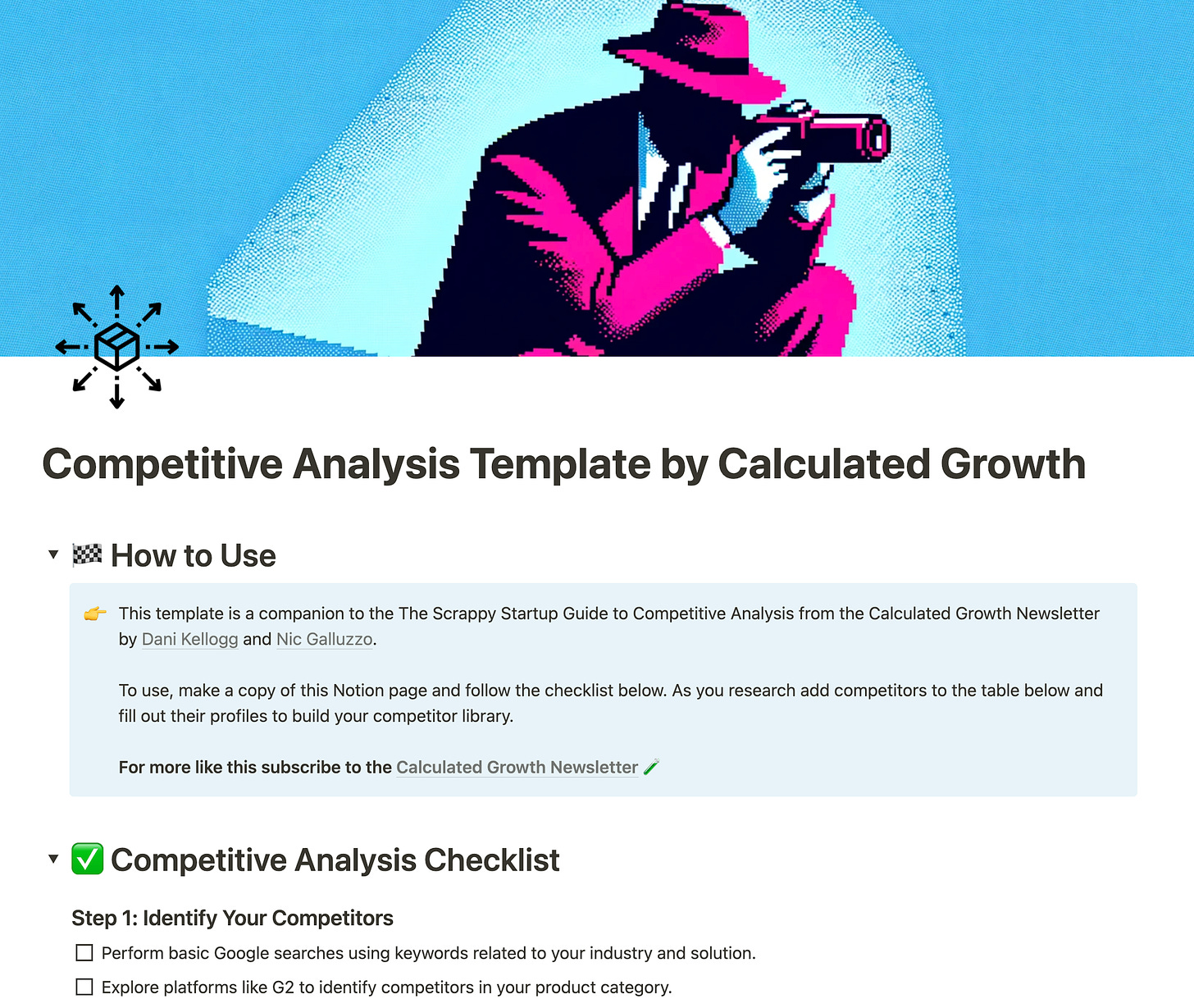The Scrappy Startup Guide to Competitive Analysis
With Free Template & Without All the Expensive Tools
👇 TLDR - grab our free competitive analysis template at the end of this post. 👇
If you want to win, you need to understand who you are playing against.
This applies to all sizes and types of companies - honestly, anyone selling someone something. Even if you feel like you don't have competitors - spoiler, you do. Competitors are any other product or reason customers choose over you.
So even if they don't choose another product - they can choose to do nothing at all and stick with the status quo.
However, competitive analysis often isn't prioritized and feels overwhelming. Where do you even get started, or should you use a tool (which is usually expensive and not prioritized on your startup budget).
The truth is, you don't need expensive tools to get a clear picture of your competition. Here's how you can build an effective competitive analysis with minimal cost.
Step 1: Identify Your Competitors
The first step in any competitive analysis is identifying your competitors, including both direct and indirect competitors. Direct customers offer a similar product or service, and indirect competitors cater to the same customer needs but in different ways. Depending on how much internal data you have or how long your company has been around, you might have more or less to start with.
How to Implement
First, start with basic Google searches using keywords related to your solution, use case, and industry - this will help you get the gist.
From there, go to sources like G2 and look at competitors in relevant categories that match your product. Further, industry reports are often available for free or at a low cost from trade associations or business websites.
Next, social media, like LinkedIn, are also great resources for identifying competitors, as they often feature discussions about industry leaders and emerging players.
Next, if you know your audience, find out where they hang out, like Slack communities, Reddit, Meetups, etc. This is a great place to see what tools people recommend and why.
Talk to your sales team - they, more than anyone in the company, have their ear to the ground and know who customers are mentioning. If you have win/loss data, this is also a great place to research.
Without paying for tools or services to curate this for you, this is a bit overwhelming. The goal here, however, is to get the gist and list any competitors you can find.
Step 2: Gather Foundational Information
Okay, now you have your list of competitors. The more you know about your competitors, the better you can understand what you're up against. So, it's time to start gathering the basics.
How to Implement
Start by reviewing each competitor's website, press releases, blogs, public profiles, etc.
How are they positioning themselves?
Who appears to be their audience?
What benefits are they talking about?
What type of pricing model do they offer?
Check out tools like Crunchbase to gauge the size and stage of the company:
Have they raised funding?
When were they founded?
Use free tools, like SimilarWeb, for basic insights into web traffic and online presence - this can be a start to understanding market share.
Attend industry webinars, which often feature discussions about market trends and key players.
If you are strapped for time, focus on your direct competitors. Or if you have internal insights, whoever you find yourself going up against a lot. The goal of this step is to start building a complete picture of your competitors. It's not just about what products they offer but also how they position themselves in the market, their pricing strategies, and their overall business model.
Step 3: Analyze Products and Services
Now, you know more about how your competitors position themselves and their target audience. The next step is deeply understanding your competitors' products and services, which help you identify what sets your offering apart.
How to Implement
Get back on their website - dig into how they message their product.
How is their product packaged?
Do they have a suite of products or just one?
How often do they release new features or updates?
What top value props do they discuss for their product(s)?
Be a spy. If you can, sign up for free trials of competitors' products to get a feel for their product experience.
How is their onboarding structured?
How does their product stack up to yours?
The goal here is to come away with a solid understanding of their product offering. Imagine you are trying to close a deal and need to tell them why your product is better than your competitor's - this is the information you are trying to understand.
Step 4: Examine Sales and Marketing Strategies
Great, you know who your customers are, how they are positioning themselves, and a bit more about their product. Next up is analyzing how competitors market their products. This helps you form the angle of how you approach messaging your product and enables you to spot any gaps in their strategies that you could benefit from.
How to Implement
You've already spent time on their website, and now it's time to observe their online marketing tactics, including social media presence, content marketing efforts, and SEO strategies.
How often do they post on social media?
Note, also look at the leadership and founders pages, this often ties into their thought leadership strategy.
What are they talking about often on their blog? Any themes?
What types of events or webinars are they either attending or hosting?
This might be trickier, but take a look at their sales strategies.
You signed up for their free trial - did sales reach out?
If they don't have a free trial - how do you get started?
If your prospects are mentioning competitors - what are they saying?
The goal is to better understand how they are taking their product to market. So what are they saying, how often, etc.
Step 5: Customer Reviews and Feedback
Alright, now it's time to dig into customer reviews. Websites and social profiles are really like highlight reels. On the other hand, customer reviews are the goldmine of information about what customers actually like and dislike about your competitor's products and services.
How to Implement
Get back to sites like G2, Capterra, GetApp, Trustpilot. Read through both the positive and negative reviews to get a balanced view of the customers' experiences.
What themes are popping up?
Do they have a ton of reviews, or not that many?
The goal here is to understand what customers are really saying about the product. This gives you a great angle for marketing and sales as you message your product.
Step 6: Synthesize Your Research
By now, you've accumulated quite a bit of info about your competitors. It's likely a big, messy doc, but that's okay - now it's time to make sense of it.
How to Implement
Start with a SWOT analysis so you can understand the strengths, weaknesses, opportunities, and threats related to your competitors and your own business. You probably have enough from the earlier steps to build this, but don't hesitate to go back to any earlier step for more details.
Strengths: Do they have more features? Are they cheaper? How do they differentiate themselves from other products?
Weaknesses: Do they have poor customer service? Is their product buggy?
Opportunities: What do they have that they can leverage? Strong partnerships? New tech advances?
Threats: What external threats exist? Changing market trends? Economic downturns?
Recap their positioning and messaging by pulling key headlines, quotes, or messaging from their website.
What words are they using? Are they trying to coin a new term? Or create a new category?
Understand the pricing options and breakdown.
What types of plans do they have?
Is their pricing public?
The goal is to come away with a comprehensive doc you can refer to that isn't information overload. Think, single table where you can link to deeper research or assets if you have them.
Step 7: Monitor & Refine
As you know, things move fast, especially with AI nudging into every industry. Your work here is never done. This was just the first step so you can have a foundation to continue refining. Regularly monitoring your competitors ensures you stay up-to-date with any changes in their strategies or market position.
How to Implement
Keep your eye on them - set up Google Alerts for your competitors, follow them on social media, and subscribe to their newsletters.
Join Slack communities and industry groups on LinkedIn for the latest news and discussions.
Decide on a regular cadence to review your competitive intel and update it.
The goal here is to remember that nothing is ever perfect, and the best way to get the most out of this is to make it a living document.
Making Your Research Actionable
Okay, so you have your competitor intel documented, and now you want to make sure it is accessible and impactful. This means turning this information into digestible assets or insights your team can use.
Sales Enablement: Create battle cards and training sessions for your sales team. These are quick-reference guides and learning sessions that detail how your product or service stacks up against competitors.
Use your research to fill in each battle card with key information about one competitor.
Keep them concise and easy to use during sales conversations. If they are too long no one will use them, these should be scannable.
Educate your team on competitors' products and strategies.
Develop counter-arguments for common objections based on competitors' weaknesses.
Product Strategy: Use your competitive intel to inform your product roadmap:
Are you missing features that competitors offer and customers value?
Are there emerging trends across your competitors?
Can you improve your product based on feedback from competitors' products?
Marketing Strategy: Use your findings to inform your marketing strategy:
Can you tailor your messaging to shine a light on competitor gaps?
Are there any strategies that are working well for competitors that you can adopt?
Are there underserved market segments that competitors are ignoring?
Competitive analysis is a critical component of any startup's strategy, and without it, you are flying blind. I know it can seem intimidating at first, but it doesn't have to be complex or overly complicated. With these steps, you can gain a solid understanding of your competitive landscape and use this research to make more informed decisions.
Grab the Template
Lastly, we created a free competitive intel template to use along with this guide to build your foundational competitive intel.







